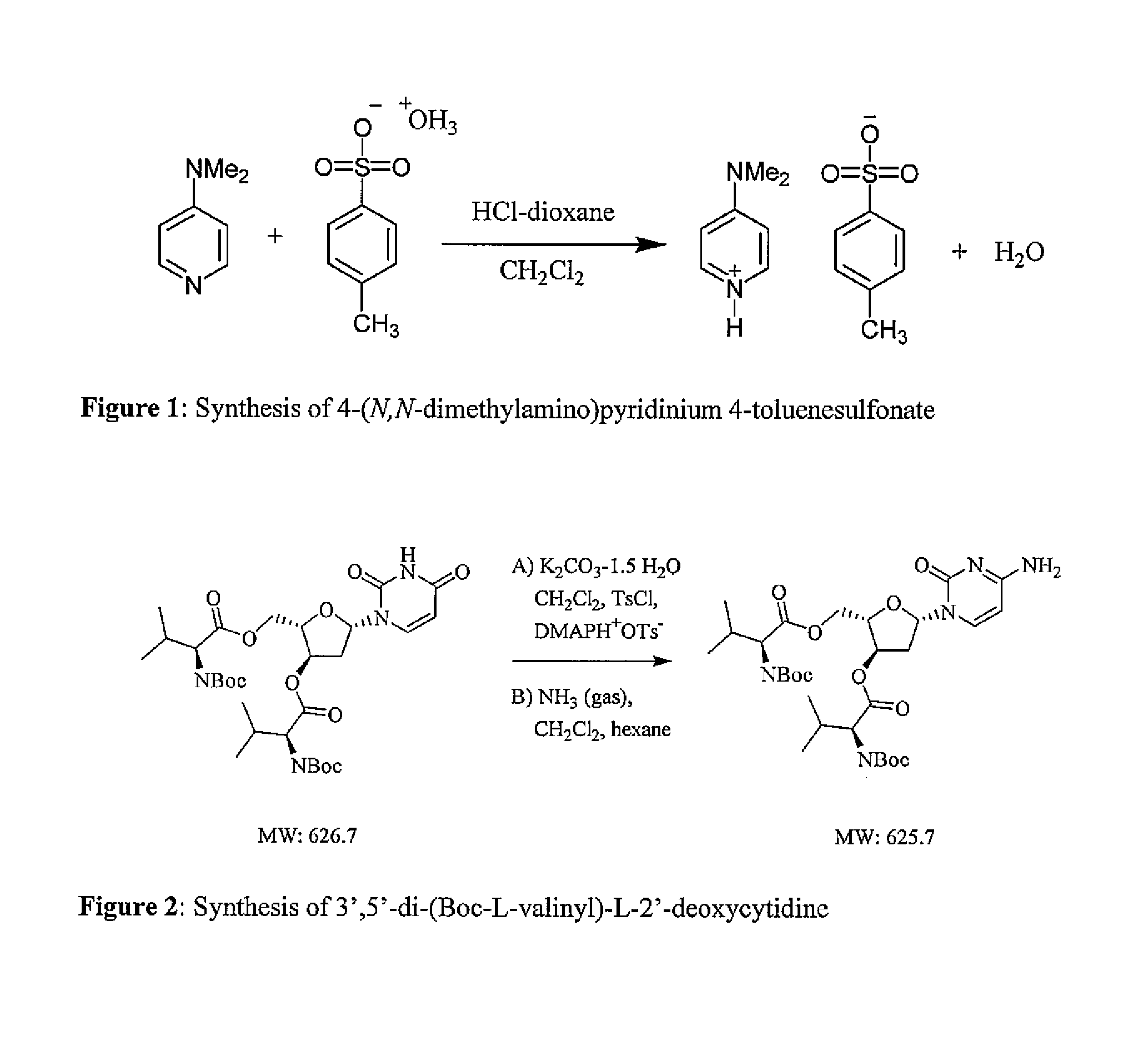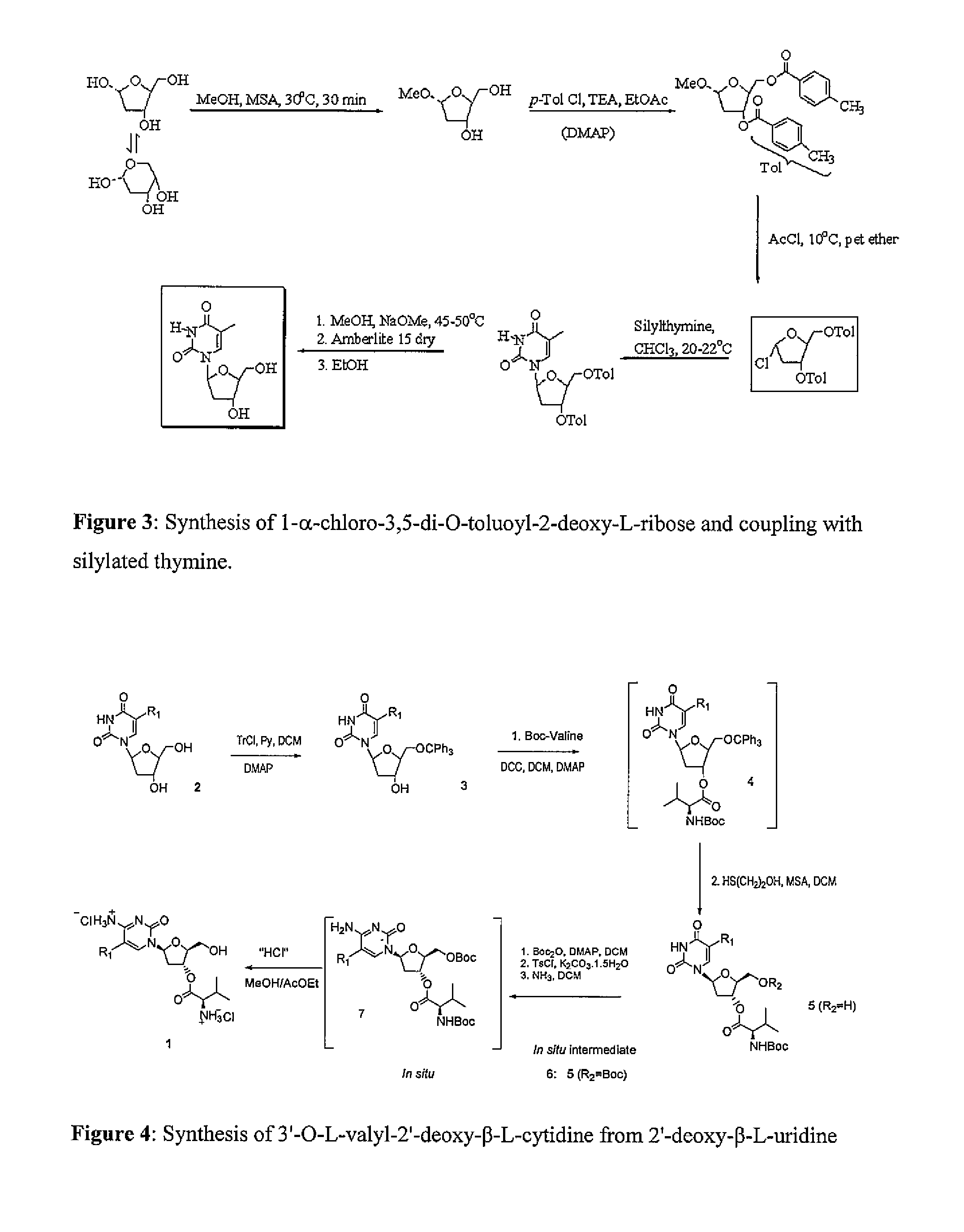Methods of manufacture of 2'-deoxy-beta-L-nucleosides
a technology of beta-l-nucleosides and deoxynucleosides, which is applied in the preparation of sugar derivatives, monosaccharides, esterified saccharide compounds, etc., can solve the problems of fulminant hepatitis, high blood levels of certain enzymes, and inability to meet the requirements of the solvent, and achieve good yield. , the effect of high stereoselectivity
- Summary
- Abstract
- Description
- Claims
- Application Information
AI Technical Summary
Benefits of technology
Problems solved by technology
Method used
Image
Examples
example 1
2-deoxy-L-ribose methyl glycoside
[0312]The starting materials include 2-deoxy-L-ribose, 27 Kg; methyl alcohol, 189 Lt; methanesulfonic acid, 0.27 Lt; dimethylaminopyridine, 2.46 Kg; toluene, 55 Lt.; ethyl acetate, 28 Lt.
[0313]To conduct the methyl glycoside formation, methanol, 162 Lt, is charged into the reactor with stirring. Then the starting sugar, L-2-deoxyribose, 27 Kg, is dissolved in the methanol and the temperature maintained at 25-30C. Next the acid catalyst methanesulfonic acid, MSA, 0.27 Lt, is dissolved in methanol, 27 Lt, and added.
[0314]The reaction is followed by thin layer chromatography to confirm complete transformation (usually 15-30 minutes) (tlc DCM / MeOH, 9:1). The acid catalyst is then quenched by addition of dimethylamino pyridine, DMAP, 2.46 Kg. The reaction medium is stirred for about 30 minutes at which time the pH is confirmed to be about 9.
[0315]The methanol is distilled under vacuum taking care to hold the temperature below 50° C. When distillation is e...
example 2
3,5—O-Ditoluoyl-2-deoxyribose methyl glycoside
[0317]The reagents include ethyl acetate, 108 Lt.; toluoyl chloride, 55.8 Lt.; triethylamine, 66 Lt.
[0318]The protected methyl glycoside is produced by acylating the methyl glycoside of Example 1
[0319]The product from step 1 is dissolved in ethyl acetate, 54 Lt, and under argon, the contents are stirred and cooled to 3-5° C. Triethyl amine, TEA, 6 Lt, is added and cooling liquid is circulated at 3-5° C. Toluoyl chloride, 55.8 Lt, in ethyl acetate, 54 Lt, is then pumped into the above mixture at a rate such that the temperature of the reaction mixture does not rise above 15-17° C. This condition is maintained for the first 50% of the addition. After that, the cooling system is stopped and the addition continued allowing the reaction to achieve 32-35° C. Stirring is continued and the progress of the reaction is evaluated by tlc (hexane / ethyl acetate, 3 / 1) every two hours, and, when the reaction is apparently completed, evaluated by HPLC. U...
example 3
Chlorosugar
[0321]The reagents include the product from step 2, equivalent to 7.5 Kg of 2-deoxy-L-ribose; acetyl chloride, 30 Lt.; petroleum ether, 36 Lt.; methyl alcohol, 6 Lt.
[0322]The chloro sugar is produced by exposing the product of Example 2 to a collateral substitution reaction.
[0323]According to this discovery of the invention, a glass-lined reactor is charged with the ethyl acetate solution from step 2 containing the equivalent of 7.5 Kg of 2-deoxy-L-ribose. The ethyl acetate is removed by vacuum distillation (temperature in the jacket is 50° C.). The temperature of the mixture is lowered to 25° C. and the vacuum broken letting Argon into the reactor.
[0324]Following the ethyl acetate removal, acetyl chloride is charged to the reactor, 30 Lt, followed by pet. ether, 30 Lt. The mixture is stirred under argon and the temperature of the solution lowered to 8-10° C. Methanol, 6 Lt, in pet. ether, 6 Lt is then pumped in the reactor keeping the temperature between 8-10° C. Total t...
PUM
| Property | Measurement | Unit |
|---|---|---|
| temperatures | aaaaa | aaaaa |
| temperature | aaaaa | aaaaa |
| temperature | aaaaa | aaaaa |
Abstract
Description
Claims
Application Information
 Login to View More
Login to View More - R&D
- Intellectual Property
- Life Sciences
- Materials
- Tech Scout
- Unparalleled Data Quality
- Higher Quality Content
- 60% Fewer Hallucinations
Browse by: Latest US Patents, China's latest patents, Technical Efficacy Thesaurus, Application Domain, Technology Topic, Popular Technical Reports.
© 2025 PatSnap. All rights reserved.Legal|Privacy policy|Modern Slavery Act Transparency Statement|Sitemap|About US| Contact US: help@patsnap.com



